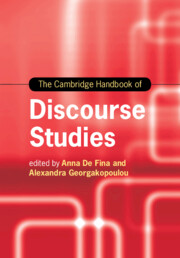Book contents
- The Cambridge Handbook of Discourse Studies
- Cambridge Handbooks in Language and Linguistics
- The Cambridge Handbook of Discourse Studies
- Copyright page
- Contents
- Figures
- Tables
- Contributors
- Preface
- Part I (Con)Textualizing Discourses
- Part II Perspectives and Modes of Analysis
- Part III Discourse Materialities and Embodiment
- Part IV (Trans)Locations and Intersections
- Part V Ethics, Inequality and Inclusion
- Part VI Discourses, Publics and Mediatization
- 27 The Critical Analysis of Genre and Social Action
- 28 Rhetorics, Discourse and Populist Politics
- 29 The Discourses of Money and the Economy
- 30 Corporate Discourse
- 31 Mediatized Communication and Linguistic Reflexivity in Contemporary Public and Political Life
- 32 Discourse Analysis and Digital Surveillance
- Index
- References
30 - Corporate Discourse
from Part VI - Discourses, Publics and Mediatization
Published online by Cambridge University Press: 28 September 2020
- The Cambridge Handbook of Discourse Studies
- Cambridge Handbooks in Language and Linguistics
- The Cambridge Handbook of Discourse Studies
- Copyright page
- Contents
- Figures
- Tables
- Contributors
- Preface
- Part I (Con)Textualizing Discourses
- Part II Perspectives and Modes of Analysis
- Part III Discourse Materialities and Embodiment
- Part IV (Trans)Locations and Intersections
- Part V Ethics, Inequality and Inclusion
- Part VI Discourses, Publics and Mediatization
- 27 The Critical Analysis of Genre and Social Action
- 28 Rhetorics, Discourse and Populist Politics
- 29 The Discourses of Money and the Economy
- 30 Corporate Discourse
- 31 Mediatized Communication and Linguistic Reflexivity in Contemporary Public and Political Life
- 32 Discourse Analysis and Digital Surveillance
- Index
- References
Summary
Starting from the premise that discourse is what brings organizations into being, this chapter presents a state-of-the-art review of research on corporate discourse. Its main goal is to evaluate the contributions that discourse analytical perspectives and methodologies have made to the understanding of organizational practices, showing how corporations use discourse strategically to create and maintain corporate identity and perform ideological work. This chapter is divided into two parts. The first part reviews studies concerned with aspects of internal communications, highlighting discursive strategies for “doing” business and adopted across contexts and media including business meetings, job interviews and business emails. The second part discusses studies investigating external communications, focusing specifically on communications with investors and stakeholders as well as with the wider world. Studies exploring CEO letters, annual and corporate social responsibility (CSR) reports, advertising and branding are reviewed. This part also discusses research that examined corporate communications in “moments of crisis,” showing how corporations strategically employ discourse to maintain a positive public image. The final sections summarize the implications and the need for “doing” discourse analysis in corporate environments and conclude with avenues for further research.
Keywords
- Type
- Chapter
- Information
- The Cambridge Handbook of Discourse Studies , pp. 666 - 686Publisher: Cambridge University PressPrint publication year: 2020
References
Further Reading
Using a combination of CDA and corpus linguistics, this volume offers comprehensive insights into the ways in which discourse constructs and maintains corporate identity and relationships with internal and external audiences. A wide range of written genres produced by corporations are explored in depth.
This book presents an excellent introduction to the role of language in many facets of business communication including stakeholder communication, brand narratives and management of conflict and self-branding. Each topic is discussed in an engaging way by drawing on a range of authentic examples.
References
- 4
- Cited by



